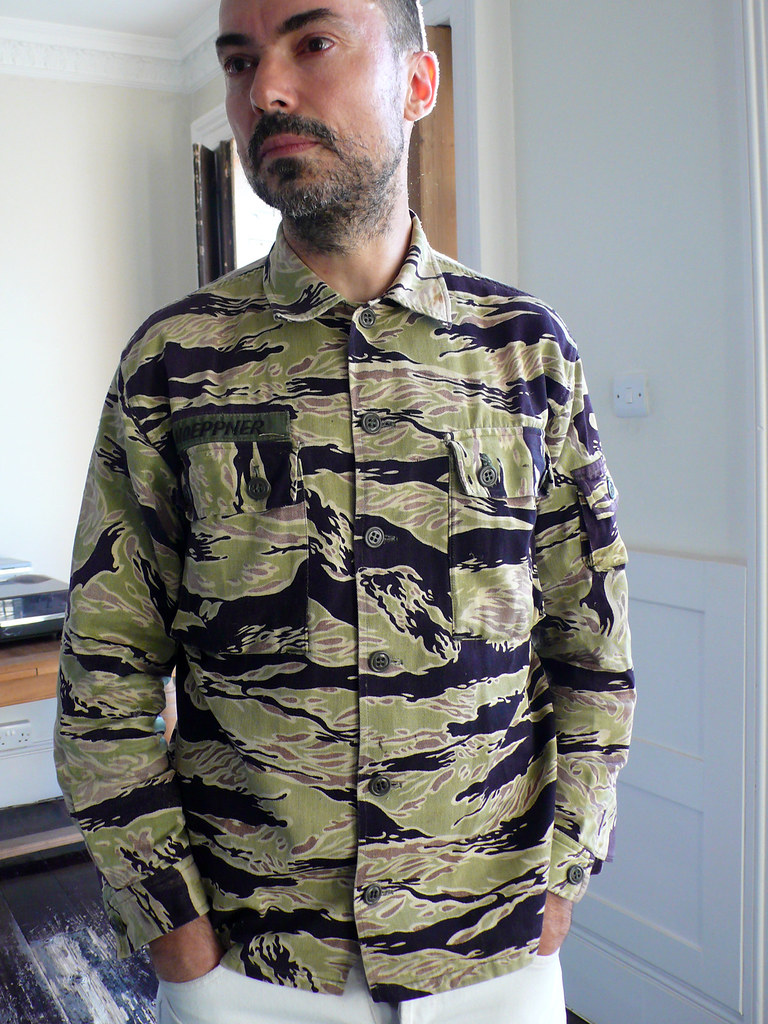Every wardrobe tells a story. Of course, some stories are more captivating than others and here at Style Salvage, we strive to seek out the most interesting to share with you. Almost all of us are all obsessed, or at the very least intrigued, by a particular item, era or theme of clothing. Tim Soar is a long time collector of vintage military garments and this interest frequently trickles down to his own collections. Therefore, it should come as little surprise that when asked to reveal a treasured item, he plumped for a favoured item from his ever growing archive. Here, Soar himself sets the scene and describes just why his Gold Tiger Stripe shirt is so special.
----------
Tim Soar and the Gold Tiger Stripe shirt.
Dialectics and Tiger Stripe. "One through nine, no maybes, no supposes, no fractions."
Scene 1. The Death Of The 1960s as told in Apocalypse Now
Captain Willard (Martin Sheen). The self obsessed Army assassin, the embodiment of American 'might is right', slowly realising that he is on the loosing side. End point: the previously unimaginable American defeat in Vietnam
The Photojournalist (Dennis Hopper). The whacked out hippy photographer who is starting to believe that the ultimate 'trip' is pure Nietzschean will and that truth lies beyond good and evil. End point: Charles Manson
The two sides of the American dream lost and adrift. Both wear Tiger Stripe camouflage fatigues.
Scene 2. The Clash at Shea Stadium. The Combat Rock Tour. The end of 1970s (in 1982).
Joe Strummer and Paul Simonon wear a strange mix of Tiger Stripe fatigues and 1950s American rockabilly clothing. The rockabilly clothing representing a time when rock and roll was still pure, before the corporate rock whore excess of the mid-1970s, the Tiger Stripe fatigues represent the spirit of punk confrontation, again a rejection of the of the pre-76 music scene. This is early Post-Modern dressing - an era that we are still in - where disparate items of clothing are mixed and matched to tell stories about the wearer. We now call it 'vintage'
I was born in the 1960s and grew up in the 1970s and these two scenes illustrate why this Gold Tiger Stripe shirt has a strong emotional resonance for me. From the point of view of a fashion designer, Tiger Stripe camouflage is fascinating. The uniforms where originally issued to South Vietnamese forces in the late 1950s/early 1960s before being appropriated by in-country elements of the US Army throughout the Vietnam war. They where predominately manufactured in Japan. The proportions of the garments are always slightly wrong with most uniforms in tiny Asian sizes, while those made especially for Americans usually having weirdly short arms and legs. This gives the shirts and trousers a slightly naive quality. There are many variations of the camouflage design that veer from subdued greens to vivid golds, while all retain the strong black horizontal stripes that are the distinctive feature of this pattern. The inks are screen printed onto cotton (rather than vat dyed like modern uniforms), therefore each item of clothing will fade and soften in a unique way. All this makes vintage Tiger Stripe feel much closer to the hippy and the punk than it does to the soldier. Finally, all Tiger Stripe, and particularly Gold Tiger Stripe, is now stupendously expensive. I found this shirt at Camden Market 10 years ago, and I always feel a smug sense of satisfaction knowing that I paid only a fraction of it's potential resale price. I know, its the little things.....
----------


1 comment:
What a striking shirt. I can see why Tim is so fond of it.
Post a Comment